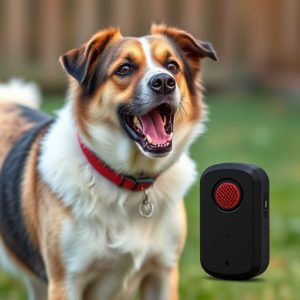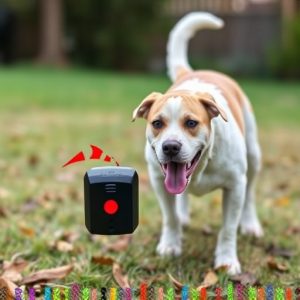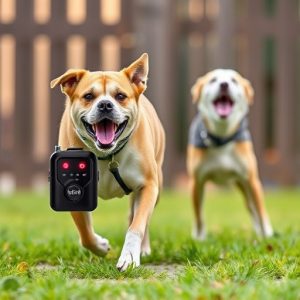Sonic Dog Repeller: Effective Training with Optimal Installation
Dogs can be trained to modify unwanted behaviors like barking or chewing using ultrasonic dog repell…….
Dogs can be trained to modify unwanted behaviors like barking or chewing using ultrasonic dog repellents, which emit high-frequency sounds inaudible to humans. When installing these devices, consider your dog's behavior and routine, placing them near problem areas like windows or entry points for barking, or furniture for chewing. Outdoor installations in areas where problems occur most frequently, at 3-5 feet above ground, are optimal. Keep repellents away from non-target animals, humans, windows, doors, food storage, and bird feeders. Training involves introducing the device in calm settings with basic commands and rewarding positive behavior changes.
Dog training can be a rewarding process, but understanding canine behavior is key. An innovative tool gaining popularity is the ultrasonic behavior modifier, a safe and effective way to train pets. This article explores how these devices work and their numerous benefits, from reducing barking to modifying unwanted behaviors. We’ll guide you on where to strategically install the sonic dog repeller for optimal results, ensuring a harmonious home environment.
- Understanding Dog Behavior and Ultrasonic Devices
- Benefits of Using a Sonic Dog Repeller
- Where to Install the Device for Optimal Effectiveness
- Safety Considerations and Precautions
- Training Your Dog with the Ultrasonic Modifier
Understanding Dog Behavior and Ultrasonic Devices
Dogs, like humans, have unique behaviors and preferences. Understanding your dog’s behavior is crucial for effective training and modification. Dogs primarily respond to positive reinforcement, where they are rewarded for desired actions. Ultrasonic devices, such as sonic dog repellents, leverage this understanding by using high-frequency sound waves that are inaudible to humans but disruptive to dogs. These tools can be particularly useful for modifying unwanted behaviors like barking, jumping, or chewing.
When considering the use of an ultrasonic device, it’s essential to determine the best location to install the sonic dog repeller. The placement should take into account the specific behavior you’re targeting and your dog’s routine. For example, if excessive barking is an issue, placing the device near windows or entry points can help deter barking at intruders. If a dog tends to chew on furniture, positioning the repeller in areas where they frequently engage in this behavior can be effective. Always follow the manufacturer’s instructions for safe and optimal placement.
Benefits of Using a Sonic Dog Repeller
Using a sonic dog repeller offers several advantages for pet owners looking to modify their dog’s behavior. These devices emit high-frequency sound waves that are inaudible to humans but can effectively deter dogs from unwanted actions like barking excessively, digging, or jumping on furniture. Unlike traditional punishment methods, which can create fear or stress, sonic repellers promote positive reinforcement by encouraging desired behaviors without causing harm.
When considering where to install a sonic dog repeller, choose areas that are strategically located based on the problematic behavior. For instance, if your dog tends to bark at visitors, place the device near entry points like doors or windows. If digging in specific spots in your yard is an issue, install it close to those problem areas. This targeted placement ensures maximum effectiveness while minimizing any potential disruption to other household members or pets not affected by the behavior.
Where to Install the Device for Optimal Effectiveness
For maximum effectiveness, the sonic dog repeller should be strategically placed in areas where unwanted canine behavior occurs most frequently. Typically, these devices are best installed outdoors, such as in gardens, patios, or decks, as they emit high-frequency sound waves that are ineffective on human ears but can deter dogs effectively. Ensure the device is mounted at a height of 3-5 feet (1-1.5 meters) above ground level to cover a broader area and reduce potential interference from surrounding structures.
When positioning the sonic dog repeller, consider the direction of wind flow and any natural barriers like hedges or fences that could absorb or reflect sound waves. Facing the device towards common dog entry points, such as gates or paths, can further enhance its deterrence capabilities. Regularly testing and adjusting the device’s settings based on environmental factors and changing behavior patterns is also recommended to maintain optimal performance.
Safety Considerations and Precautions
When using an ultrasonic dog repeller, safety should be your top priority. These devices emit high-frequency sound waves that are inaudible to humans but can effectively deter dogs. However, not all environments or pets are suitable for this method. Always ensure the device is placed where it will not harm children or other pets that cannot hear these frequencies. Avoid using them near food storage areas or places where non-target animals may gather, such as bird feeders.
To maximize safety and effectiveness, carefully consider where to install the sonic dog repeller. Outdoor areas like patios, gardens, or fences are ideal locations. Make sure the device is away from windows or doors to prevent any unintended noise disturbance inside your home. Additionally, keep it out of reach of curious pets and children to avoid accidental activation or tampering. Regularly check the device’s batteries and settings to ensure it operates optimally and safely.
Training Your Dog with the Ultrasonic Modifier
Training your dog with an ultrasonic behavior modifier involves strategically placing the device in areas where unwanted behaviors occur. This high-tech tool emits a silent, inaudible sound that disrupts your dog’s focus, encouraging them to stop and reassess their actions. The key is to position the repeller near triggers for specific behaviors – whether it’s a door leading to a high-traffic area, a window where your pup tends to bark at passersby, or even their bed if they have a habit of whining during the night.
When introducing the ultrasonic modifier, start with basic commands like “sit” or “stay” in a calm environment. As your dog successfully completes the task, reward them and let them know they’re doing well. This positive reinforcement will help them associate the sound with a good outcome rather than fear or frustration. Gradually increase difficulty levels as their understanding improves, moving on to more complex behaviors like leaving objects alone or not jumping on furniture.
When training your dog, integrating a sonic dog repeller can be an effective solution for modifying unwanted behaviors. By understanding dog behavior and utilizing ultrasonic devices, you can create a harmonious living environment. Remember, the key to success lies in strategic placement—where to install the sonic dog repeller matters for optimal effectiveness. Ensure safety precautions are followed to avoid any harm to your pet or others. With consistent training and proper use of this technology, you’ll be well on your way to transforming problematic behaviors into positive ones.


